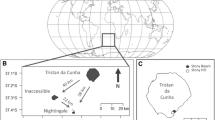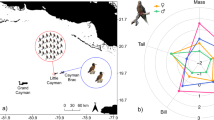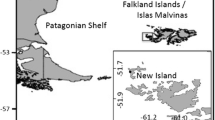Abstract
We used time-depth recorders to measure depth utilisation in gravid green turtles (Chelonia mydas) during the internesting period at northern Cyprus (Mediterranean), a nesting area where individuals feed, and at Ascension Island (mid-Atlantic), a nesting area where individuals fast. There were contrasting patterns of depth utilisation between the two sites, illustrating that the behaviour of this species is shaped by local conditions. For example, the amount of time spent shallower than 4 m was 90% at Cyprus but only 31% at Ascension Island, and there was a clear difference between the mean depth at Cyprus (2.7 m, n=9 internesting intervals) versus Ascension Island (9.5 m, n=6 internesting intervals) (t 5=5.92, P=0.002). At Cyprus, turtles spent the greatest percentage of their time at very shallow depths, where surveys reveated a high abundance of seagrass on which this population feeds. In contrast, the deeper distribution at Ascension Island may reflect the preferred depth for resting on the seabed.
Similar content being viewed by others
References
Alcoverro T, Cerbian E, Ballesteros E (2001) The photosynthetic capacity of the seagrass Posidonia oceanica: influence of nitrogen and light. J Exp Mar Biol Ecol 261:107–120
Balazs GH (1980) Synopsis of the biological data on the green turtle in the Hawaiian, Islands. NOAA (Natl Ocean Atmos Adm) Tech Mem NMFS (Natl Mar Fish Serv) 7:1–141
Bjorndal KA (1980) Nutrition and grazing behaviour of the green turtle Chelonia mydas. Mar Biol 56:147–154
Brill RW, Balazs GH, Holland KN, Chang RKC, Sullivan S, George JC (1995) Daily movements, habitat use, and submergence intervals of normal and tumour-bearing juvenile green turtles (Chelonia mydas L.) within a foraging area in the Hawaiian Islands. J Exp Mar Biol Ecol 185:203–218
Carr A (1967) The turtle a natural history. Cassell, London
Carr A, Ross P, Carr S (1974) Internesting behavior of the green turtle, Chelonia mydas, at a mid-ocean island breeding ground. Copeia 1974:703–706
Davis EE, Rice MR, Harrington KA, Balazs GH (2000) Green turtle diving and foraging patterns in Puako, Hawaii. In: Kalb H, Wibbels T (eds) Proceedings of the 19th annual symposium on sea turtle conservation and biology NOAA (Natl Ocean Atmos Adm) Techn Memo NMFS (Natl Mar Fish Serv) 443:153–154
Hays GC, Adams CR, Broderick AC, Godley BJ, Lucas DJ, Metcalfe JD, Prior AA (2000) The diving behaviour of green turtles at Ascension Island. Anim Behav 59:577–586
Hochscheid S, Godley BJ, Broderick AC, Wilson RP (1999) Reptilian diving: highly variable dive patterns in the green turtle Chelonia mydas. Mar Ecol Prog Ser 185:101–112
Hulbert IAR, Andersen R (2001) Food competition between a large ruminant and a small hindgut fermentor: the case of the roe deer and mountain hare. Oecologia 128:499–508
Meylan A (1995) Sea turtle migration — evidence from tag returns. In: Bjorndal KA (eds) Biology and conservation of sea turtles, revised edition. Smithsonian Institution Press, Washington, DC
Mortimer JA, Carr A (1987) Reproduction and migrations of the Ascension Island green turtle (Chelonia mydas). Copeia 1987:103–113
Pirc H (1986) Seasonal aspects of photosynthesis in Posidonia oceanica: influence of depth, temperature and light intenstiy. Aquat Biol 26:203–212
Pough FH, Janis JM, Heiser JB (1998) Vertebrate life. Prentice Hall, Engelwood Cliffs, N.J.
Tucker AD, Read MA (2001) Frequency of foraging by gravid green turtles (Chelonia mydas) at Raine Island, Great Barrier Reef. J Herpetol 35:500–503
van Dam RP, Diez CE (1996) Diving behavior of immature hawksbills (Eretmochelys imbricata) in a Caribbean cliff-wall habitat. Mar Biol 127:171–178
Author information
Authors and Affiliations
Corresponding author
Additional information
Communicated by G.F. Humphrey, Sydney
Published online: 23 July 2002
Rights and permissions
About this article
Cite this article
Hays, G.C., Glen, F., Broderick, A.C. et al. Behavioural plasticity in a large marine herbivore: contrasting patterns of depth utilisation between two green turtle (Chelonia mydas) populations. Marine Biology 141, 985–990 (2002). https://doi.org/10.1007/s00227-002-0885-7
Received:
Accepted:
Issue Date:
DOI: https://doi.org/10.1007/s00227-002-0885-7




